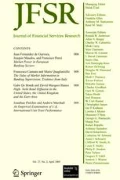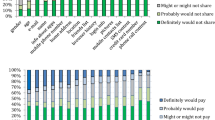Abstract
Using Dutch survey data, we show how consumer willingness to allow access to payments data depends on the type of data user (the consumer’s own bank, another bank, or a Big Tech), financial incentives and trust in the data user. Consumers are most willing to grant access to their own bank. Their propensity to share their payments data increases with their trust in the providers of these services. An explicit financial reward can tempt people to accept offers from other providers. Big Tech firms on average have to offer stronger incentives than banks, because people trust them the least.

Similar content being viewed by others
Notes
PSPs can offer the PSD2 services to both consumers and businesses. We focus on the impact of PSD2 on the consumer retail payments market.
The Centerpanel is an Internet-based survey among a representative sample of the Dutch-speaking population in the Netherlands. The Centerpanel was created in 1993 and has been widely used by both policymakers and researchers to study a broad range of topics. See https://www.centerdata.nl/en/publications.
Many studies have already shown that payment behaviour also depends on other perceived payment instrument characteristics such as security, convenience and costs. Stavins (2020) is a recent example.
For more information on the methodology see Teppa and Vis (2012).
For example, in the case of the financial overview, we included the “no financial overview” option. This increased the realism of the scenario and is in line with the design guidelines of Ben-Akiva et al. (2019).
For readability reasons, we only use a subscript denoting the respondent, but not for the three different products or three different rounds.
We tested whether there is a linear relationship between trust and the propensity to share payments data with the different service providers using dummies of respondents’ trust levels as covariates. Wald tests did not reject the hypothesis of a linear relation between trust and respondents’ willingness to give consent to use payments data at 99% confidence level, except for ‘other banks of which they are a customer’. In the latter case, the results for other variables hardly changed. This justifies using a linear relationship between trust and consumers’ propensity to share payments data.
Marginal effects are available upon request.
The marginal effects presented here are marginal effects estimated at the mean (MEM) value of the covariates in the sample. A list of all MEM effects is available upon request.
See section “Exploring heterogeneity in take-up rates by age and gender” in the Online Appendix for a further explanation how we derive the main source of heterogeneity.
References
Acquisti A, John LK, Loewenstein G (2013) What is privacy worth? J Leg Stud 42:249–274
Acquisti A, Brandimarte L, Loewenstein G (2015) Privacy and human behavior in the age of information. Science 347(6221):509–514
Arango C, Hyunh K, Sabetti L (2015) Consumer payment choice: merchant card acceptance versus pricing incentives. J Bank Finance 55:130–141
Athey S, Catalini C, Tucker C (2017) The digital privacy paradox: small money, small costs, small talk. NBER Working Paper 23488
Bansal G, Zahedi FM, Gefen D (2016) Do context and personality matter? Trust and privacy concerns in disclosing private information online. Inf Manag 53:1–21
Ben-Akiva M, McFadden D, Train K (2019) Foundation of stated preference elicitation: consumer behavior and choice-based conjoint analysis. Found Trends Econ 10(1–2):1–144
Bolt W, Jonker N, Van Renselaar C (2010) Incentives at the counter: an empirical analysis of surcharging card payments and payment behaviour in the Netherlands. J Bank Finance 34(8):1738–1744
Borzekowski R, Kiser E, Ahmed S (2008) Consumers’ use of debit cards: patterns, preferences, and price response. J Money Credit Bank 40(1):149–172
Cameron AC, Trivedi PK (2010) Micoeconometrics using Stata, Revised. Stata Press, College Station
Carare O, McGovern C, Noriega R, Schwarz J (2015) The willingness to pay for broadband of non-adopters in the U.S.: estimates from a multi-state survey. Inf Econ Policy 30:19–35
Ching A, Hayashi F (2010) Payment cards reward programs and consumer payment choice. J Bank Finance 34(8):1773–1787
D’Acunto F, Rossi AG, Weber M (2019) Crowdsourcing financial information to change spending behavior. Chicago Booth Paper No. 19–09
Ding M, Grewal R, Liechty J (2005) Incentive-aligned conjoint analysis. J Mark Res 42(1):67–82
Kosse JCM (2014) Consumer payment choices: room for further digitization? PhD thesis. Tilburg University, Tilburg
Maddala GS (1983) Limited-dependent and qualitative variables in econometrics. University Press, Cambridge, Cambridge
Magnac T (2017) ATM foreign fees and cash withdrawals. J Bank Finance 78:117–129
Miller KM, Hofstetter R, Krohmer H, Zhang ZJ (2011) How should consumers’ willingness to pay be measured? An empirical comparison of state-of-the-art approaches. J Mark Res 48(1):172–184
MOB (2016) Bereikbaarheidsmonitor 2016 (Accessibility monitor 2016). MOB, Amsterdam
Prince J, Wallsten S (2020) How Much is Privacy Worth Around the World and Across Platforms? Working paper. Technology Policy Institute, Washington
Simon J, Smith K, West T (2010) Price incentives and consumer payment behavior. J Bank Finance 34(8):1759–1772
Stavins J (2018) Consumer preferences for payment methods: Role of discounts and surcharges. J Bank Finance 94:35–53
Stavins J (2020) Credit card debt and consumer payment choice: what can we learn from credit bureau data? J Financ Serv Res 58:59–90
Stulz RM (2019) FinTech, BigTech and the future of banks. J Appl Corp Financ 31(4):86–97
Teppa F, Vis C (2012) The CentERpanel and the DNB Household Survey: methodological aspects. DNB Occas Study 10(4)
Van der Cruijsen C (2020) Payments data: do consumers want banks to keep them in a safe or turn them into gold? Appl Econ 52(6):609–622
Van der Cruijsen C, Diepstraten M (2017) Banking products: you can take them with you, so why don’t you? J Financ Serv Res 52(1):123–154
Van der Cruijsen C, Knoben J (2021) Ctrl+C Ctrl+pay: Do people mirror electronic payment behavior of their peers? J Financ Serv Res 59(1):69–96
Van der Cruijsen C, Van der Horst F (2019) Cash or card? Unravelling the role of socio-psychological factors. De Econ 167(2):145–175
Van der Cruijsen C, De Haan J, Roerink R (2021) Financial knowledge and trust in financial institutions. J Consum Aff 55(2):680–714
Van Esterik-Plasmeijer PWJ, van Raaij WF (2017) Banking system trust, bank trust, and bank loyalty. Int J Bank Mark 35(1):97–111
Acknowledgements
We would like to thank colleagues at DNB and an anonymous referee for helpful comments on earlier versions of this paper and the questionnaire. We are grateful to Centdata for collecting the data. The views expressed in this paper are the authors’ and do not necessarily reflect those of De Nederlandsche Bank or the European System of Central Banks. All remaining errors are the authors’.
Author information
Authors and Affiliations
Corresponding author
Ethics declarations
Conflicts of interests/Competing interests
The authors have no competing interests to declare that are relevant to the content of this article.
Additional information
Publisher’s note
Springer Nature remains neutral with regard to jurisdictional claims in published maps and institutional affiliations.
Supplementary Information
Below is the link to the electronic supplementary material.
Rights and permissions
About this article
Cite this article
Bijlsma, M., van der Cruijsen, C. & Jonker, N. Consumer Willingness to Share Payments Data: Trust for Sale?. J Financ Serv Res 64, 41–80 (2023). https://doi.org/10.1007/s10693-022-00384-1
Received:
Revised:
Accepted:
Published:
Issue Date:
DOI: https://doi.org/10.1007/s10693-022-00384-1




